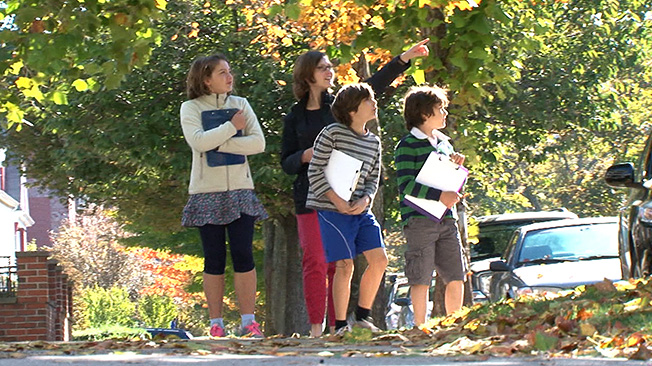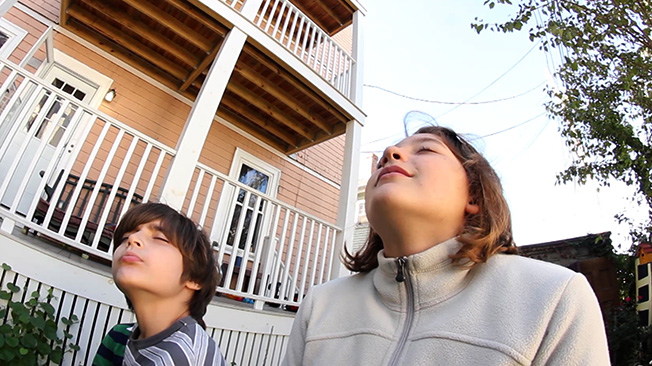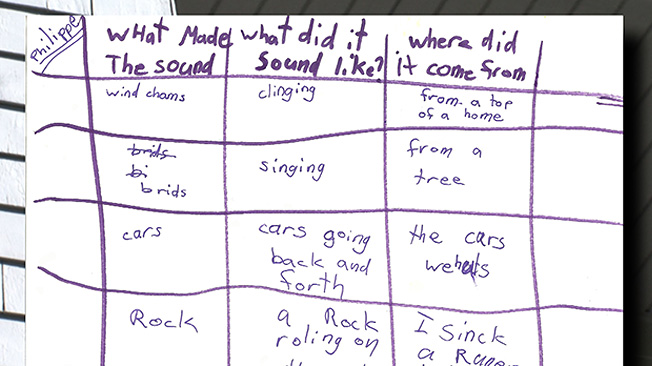Sound Safari

What Is This Activity?
You can't always see animals, but you sure can hear them! Crickets, frogs, crows, and many other animals make sounds we can easily hear even when the animals are hiding. What kinds of sounds - animal and other - will you hear on a walk around your neighborhood?
Introduction
-
-
00:00
What Are Kids Learning?
- Sound is one way to tell how many different animals live in an ecosystem.
- Animals use sounds for different reasons, including to communicate, to warn others, and to scare off predators.
- Sounds travel differently in different environments.
- People and animals make sounds using different parts of their bodies.
Activity 60 minutes

Part A Noises in the Neighborhood
Talk with your child about the kinds of sounds you might hear if you went for a walk in the neighborhood.
Ask:
- Would you hear nature sounds, like animals' noises or leaves moving in the breeze?
- Sounds made by people talking, moving around, or working?
- Traffic sounds?
- Where would you go if you wanted to hear nature sounds?
Explain to your child that you are going to go on a Sound Safari, hunting for different kinds of sounds in your neighborhood. Think of two or three different places where you expect to hear different kinds of sounds. The street in front of your house, a nearby playground, and a vacant lot or park are all places you might go.
Part B Sound Safari
- Grab a notebook and pencils and head out to one of your locations. Find a place to sit, if possible.
- Set a timer for two minutes. When you say ''GO,'' start the timer. Close your eyes, remain quiet, and listen.
- At the end of two minutes, say ''STOP.''
Talk with your child about some of the sounds you have heard.
Ask:
- What made the sound?
- What did it sound like?
- Was it loud or quiet?
- Do you think the sound was made by something large or something small?
- Jot down in your field notebook some of the sounds you heard, and briefly describe where you are. If you chose to print the ''Sounds in our Neighborhood'' chart, fill it in and tape or staple it in your field notebook when you return home.
Head to one or two additional locations and repeat the listening activity. Do you hear the same sounds or different ones? How are they different? What might be some reasons why?
- Continue your conversation. Ask questions like: What do the sounds tell us about where we were? Why do animals make sounds?
Explore Some More
Sounds around the Clock
Try this activity at different times of day or different times of year. How are the sounds of nature - and the sounds made by people - different in the morning than at sunset or in the middle of the day? You could also do this activity in different seasons or during different kinds of weather. If it's snowing, bundle up, step outside, and just listen for a few minutes. Is it quiet enough for you to hear the snow falling? Notice how other sounds, such as cars on the road, become muffled when the snow piles up. If it's raining, grab some umbrellas and step outside, just for a few minutes. What does the rain sound like? Are any animals making sounds, or are they all quiet?
Identifying Animal Sounds
What's the fun in listening to nature if you don't know what you're listening to? A number of websites and apps help in identifying common bird, insect, mammal, and frog calls. Have a listen to the eastern chipmunk's chirp, the red squirrel's trill, and the eastern gray squirrel's raspy squawk and chatter at Cornell University's Macaulay Library. The University of Florida has recordings of crickets, katydids and other insects you might hear on a summer evening, even in a city. Have you ever heard these calls? Frogs and toads call at the edges of ponds and wetlands. Listen to some common ones, such as spring peepers, American toads or American bullfrogs at the U.S. Geological Survey's Patuxent Wildlife Research Center. Do any of them sound like they're saying ''ribbit'' or ''croak''? Birds, of course, are the most obvious of nature's noisemakers. The Cornell Lab of Ornithology has a comprehensive resource on birdsong.



